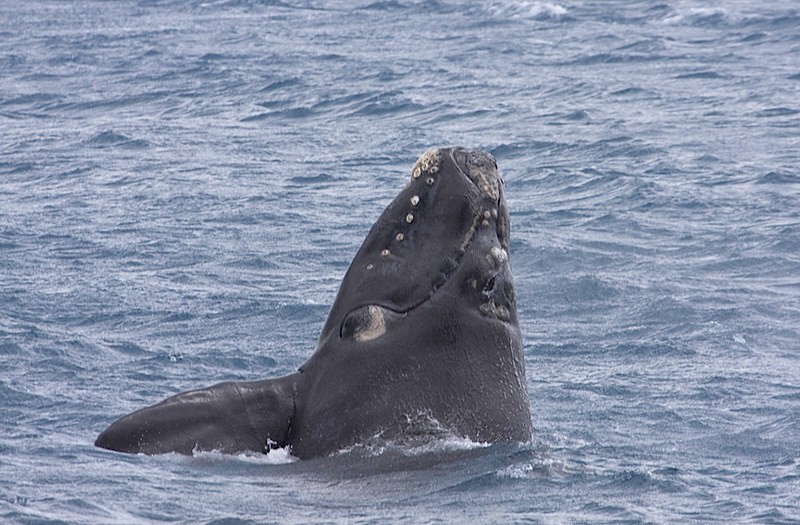Southern right whale
A species of Right whales Scientific name : Eubalaena australis Genus : Right whales
Southern right whale, A species of Right whales
Scientific name: Eubalaena australis
Genus: Right whales
Content
Description People often ask General Info
 Photo By Gregory "Slobirdr" Smith , used under CC-BY-SA-2.0 /Cropped and compressed from original
Photo By Gregory "Slobirdr" Smith , used under CC-BY-SA-2.0 /Cropped and compressed from original Description
Like other right whales, the southern right whale is readily distinguished from others by the callosities on its head, a broad back without a dorsal fin, and a long arching mouth that begins above the eye. Its skin is very dark grey or black, occasionally with some white patches on the belly. The right whale's callosities appear white due to large colonies of cyamids (whale lice). It is almost indistinguishable from the closely related North Atlantic and the North Pacific right whales, displaying only minor skull differences. It may have fewer callosities on its head than North Atlantic and more on its lower lips than the two northern species. The biological functions of callosities are unclear, although the primal role has been considered to be for protection against predators. Whale declines may have an effect on barnacle diversity and numbers. An adult female is 15 m (49 ft) and can weigh up to 47 tonnes (46 long tons; 52 short tons), with the larger records of 17.5–18 m (57–59 ft) in length and 80 tonnes (79 long tons; 88 short tons) or up to 90 tonnes (89 long tons; 99 short tons) in weight, making them slightly smaller than other right whales in the Northern Hemisphere. The testicles of right whales are likely to be the largest of any animal, each weighing around 500 kg (1,100 lb). This suggests that sperm competition is important in the mating process. Right whales do not normally cross the warm equatorial waters to connect with the other species and (inter)breed: their thick layers of insulating blubber make it difficult for them to dissipate their internal body heat in tropical waters. However, based on historical records and unconfirmed sightings in modern periods, E. australis transits may indeed occur through equatorial waters. Moreover, a stranding of a 21.3 m (71 feet) long right whale at Gajana, northwestern India in November 1944 was reported, however, true identity of this animal is unclear. The proportion and numbers of molten-coloured individuals are notable in this species compared with the other species in the Northern Hemisphere. Some whales remain white even after growing up. Life span is not clear although whales seem to reach over 100 years old. 
People often ask
General Info
Lifespan
70-100 years
Diet
Southern right whale sustains mainly on zooplankton, with krill providing a significant portion of its diet. They generally feed by skimming the ocean surface with their mouth open, filtering food from the water.
Appearance
The southern right whale are large marine mammals with elongated bodies covered in smooth, dark grey skin. They are distinguished by their enormous heads, which can measure up to one-third of their total body length. An absence of a dorsal fin, broad paddle-like flippers, and a wide, arching mouth are prominent features. Their underbellies are usually lighter, often with irregular white patches. They have no teeth, instead possessing comb-like baleen plates for filtering food.
Behavior
Southern right whale is noted for its long-distance migratory behavior, traveling from feeding grounds near Antarctica to breeding territories near the equator. Exhibiting complex vocalization, southern right whale communicates for mating or alerting others of threats. This species is primarily solitary, but engages in cooperative feeding, herding plankton with their tails.
Scientific Classification
Phylum
Chordates Class
Mammals Order
Whales and dolphins Family
Bowhead and right whales Genus
Right whales Species
Southern right whale